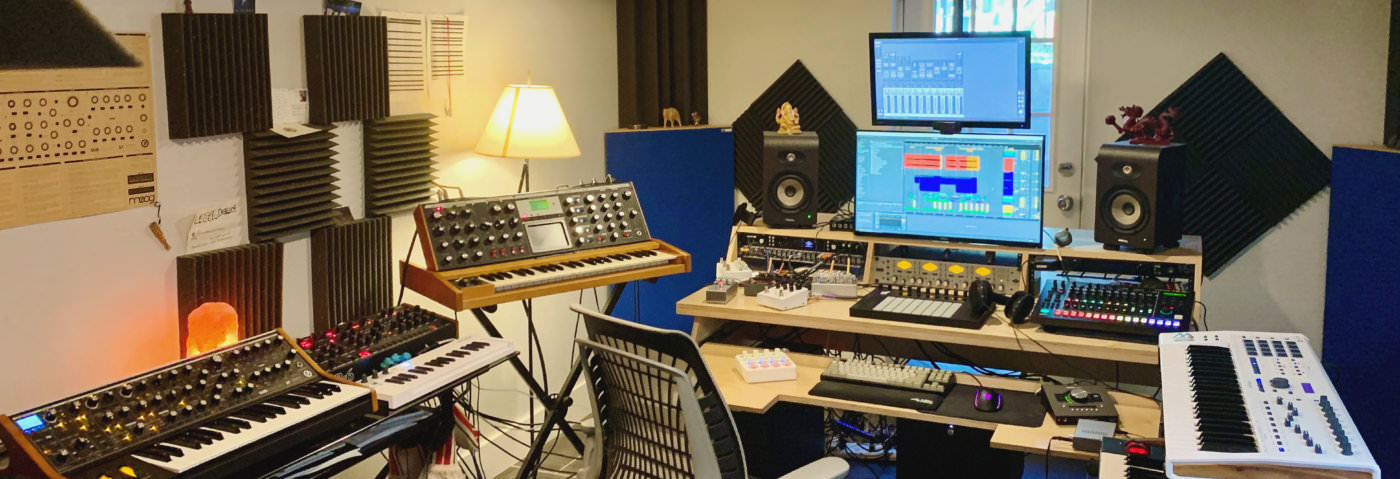Queen’s representatives, Local Dialect, like to characterize their Moog Voyager “as an old man smoking a pipe in a rocking chair, while the Sub 37 is a strapping young lad off to do some hard work like chopping down a tree or something”. As analogies go, it’s one of the more interesting, so we decided to take a look around their studio.
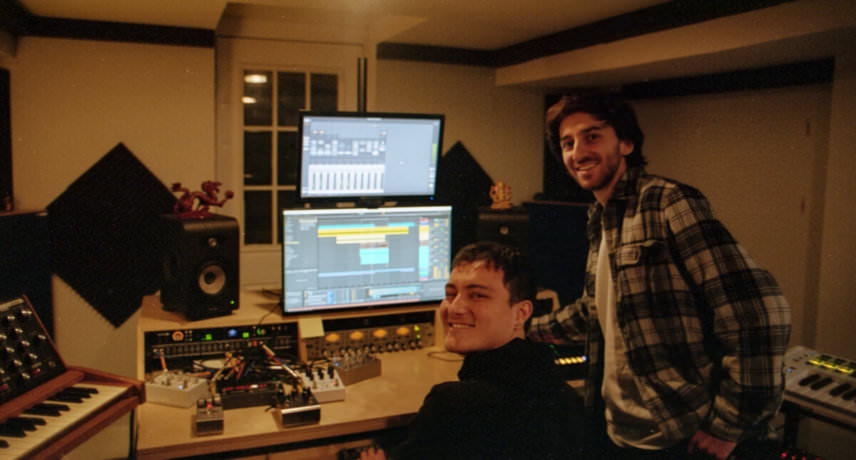
Local Dialect
Hi! We’re Reed and Sam from Local Dialect.
This is our studio in the basement of our duplex where we live in Queens, New York.
We love having 24/7 access to the studio so that we can jam whenever inspiration hits and work during odd hours. Our studio is separated from the rest of the basement by a soundproof wall that we installed. On the other side of the wall are our washer and dryer as well as a very loud air vent! The studio is also attached to a door that leads to our backyard, so we do get a little bit of sunlight in here.
When we moved into this apartment the basement was completely empty and pretty unwelcoming, but over the course of a few years, we’ve managed to create a cozy space that we’ve come to love. We’ve found it essential to invest in things like an air filter and humidifier to maintain good air quality, seat cushions and a footrest to keep us comfortable.
Also super important is sound treatment–we have bass traps in each corner and spent a lot of time tweaking the monitor and sub placement to get it right. We’ve found Sonarworks to be immensely helpful in this.
We started out as in-the-box producers but discovered the wonderful world of analog gear a few years ago and fell in love. Since then we’ve put together a nice collection of synths and hardware and shifted to a hybrid workflow. We find a hands-on approach to creating music so much more fun and inspiring than working entirely in the box! It took a bit to figure out how to record properly but once we got comfortable with that we found we could write and compose much more quickly than with a keyboard and mouse.
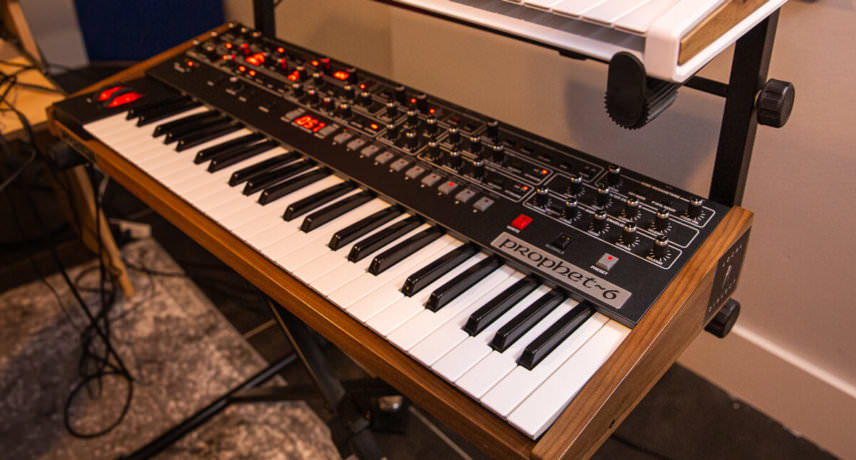


Prophet 6 – Sequential
The Prophet-6 was the first synth we ever got.
Most of the Local Dialect leads and pads come out of this gorgeous machine, for example the plucky lead in Demeter, or the arpeggio in our remix of Skin & Bones by Lane 8. We have a bunch of presets that we keep returning to, and we even maintain a spreadsheet of all our presets!
It’s also very fun to switch to a random one or program something from scratch. We often run this through our Empress Echosystem delay pedal. That combo has become one of our signature sounds.
The playability of this synth is one of its greatest assets. When we write, we usually come up with a melody, then sit down and record multiple performances while tweaking the filter and ADSR, and also playing with the mod wheel. A lot of our favorite moments are when we’re in the zone and going crazy with the modulation. It doesn’t always come out perfect but that’s part of the beauty of it!
The Prophet, like a lot of our gear, is second-hand, and the filter knob feels like it might fall off sometime soon. We haven’t had a chance to send it in to be fixed yet, because if we do we’d be utterly unable to write new music.
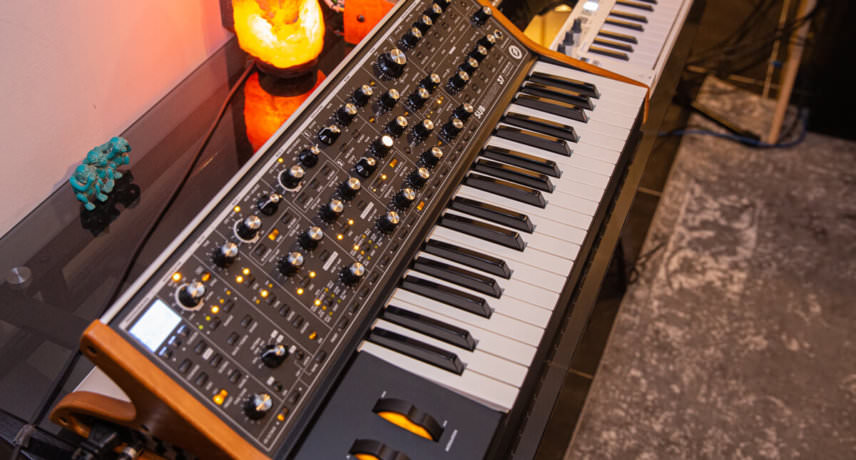


Moog Subsequent 37
We got the Moog Subsequent 37 on a fun day a couple years ago.
We walked into Main Drag Music in Williamsburg for a synth festival and told ourselves we wouldn’t buy anything. Obviously, a few hours later we emerged with it and a couple other synths in our hands. We ended up getting rid of the others, but could never bear to part with this one!
The Sub 37 is one of Moog’s more modern offerings. It’s incredibly versatile but we find ourselves instinctively turning to it for bass sounds. Whether it’s a plucked bass, muted sub-bass, or a sustained bass, this one can do it all. Check out the bass in November off our latest EP on Purified Records for a classic growly Local Dialect bass, or Varosha for a pluckier example.
One of our favorite tricks is to use both oscillators but tune the second one an octave and a fifth above the first, and turn on duo mode. This is a very emotion-laden sound that can be heard around 1:35 in the break of Pulse, the B-side of the Purified EP, and in our remix of Skalarfeld by Riamiwo we also put an LFO on the filter to really make it dance!
Occasionally we’ll use the Sub37 for a lead sound, like our remix of Mirage by Anden. We also love running it through our Strymon Deco pedal to give it movement and stereo width.
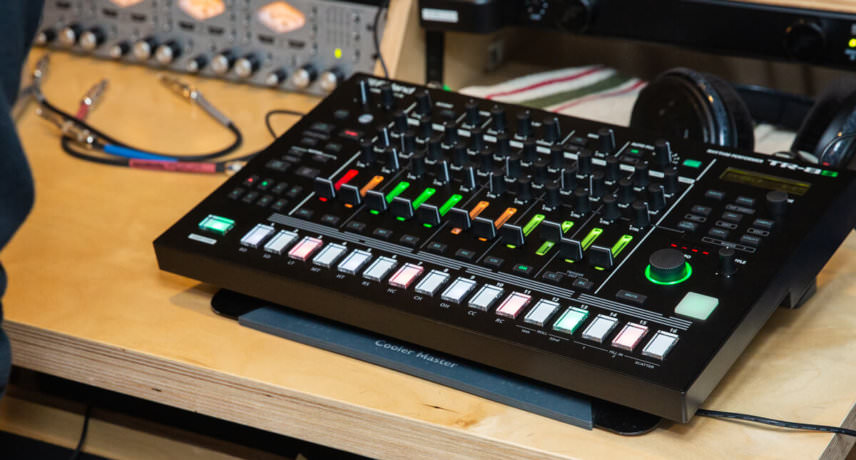


Roland TR-8S
This is the second model of Roland‘s modern drum machine, and boy do we love it.
The majority of our drums and percussion come from this beast, as it contains all of the classic Roland TR sounds (808, 909, 606, 626, you name it) as well as a bunch of more unique drums samples in a super fast and simple interface.
We used to have the earlier TR-8 model, but upgraded as soon as the new one came out. Some of the crucial features in the new model are more patterns, better pattern chaining (so you can sequence multiple 16-beat patterns), parameter automation, programmable fills, sample importing, and a ton more.
Another one of our favorites is the swing knob. We find we often end up on the shuffle side but love using both! Pulse is a great example of some cool flams on the 16th hi-hat line and that classic Local Dialect shuffle feel, while in November we used swing instead.
When we write, we will often lay down a sparse beat to keep the groove going, then as the track progresses we’ll add more layers, accents, and fills. Once we have a solid idea of where the track is going we’ll take a moment to record each sound in individually, maybe play around with the modulation while we do so, and then arrange the recordings.
Roland’s “Analog Circuit Behavior” algorithms make the digital sounds behave like their analog counterparts, so there can be a lot of variation between each instance of a sound. We often choose a small loop out of the recordings for use, sometimes even a single hit.
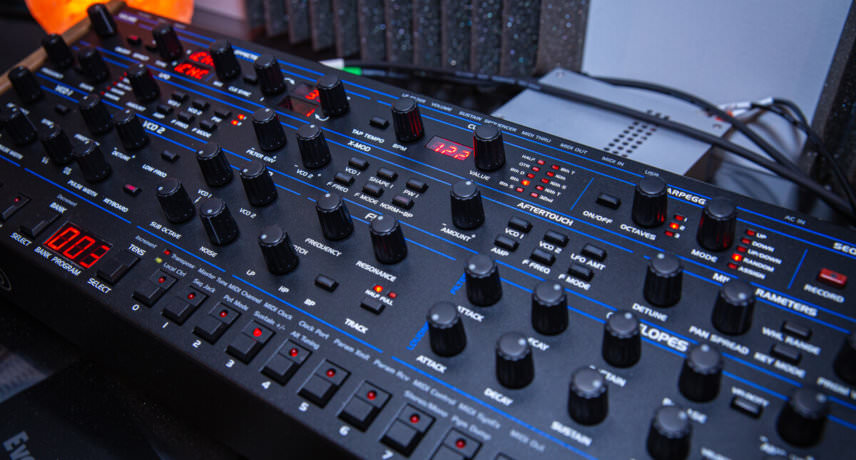


Dave Smith OB6 Desktop Module
The DSI OB-6 is our pad machine.
Patches 000 and 004 have made their way into so many of our tracks, for example the pad in November around 3:10. We always tell each other we should try some different presets but those ones are so good!
The Oberheim filter has a very distinct and recognizable sound, it’s an SEM filter as opposed to the Curtis filters on the Prophet. It has a softer character that is sometimes described as “milky,” which we think suits it quite well. There’s only one filter, but it’s variable-state which means it can smoothly transition from lowpass to bandpass to highpass. In fact, modulating the filter state leads to some very unique results that not many other synths can achieve.
Though we most often use it for background sounds, the OB-6 is also very capable of being the main actor when it needs to. Funnily enough, we used it as the main lead in both November and Pulse! It’s also very good at sound effects as a lot of the presets are random chirps and sweeps.
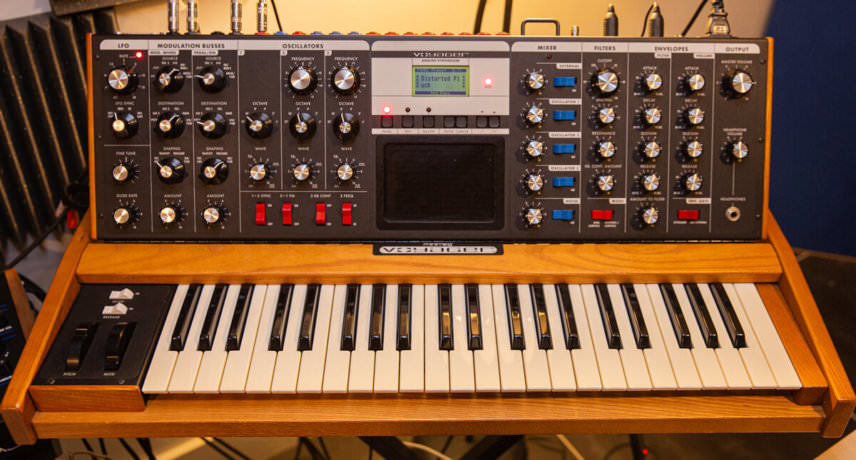


MiniMoog Voyager
The Minimoog Voyager is our most recent synth purchase.
We got it because we kept hearing it pop up in music we were listening to and really wanted to emulate those sounds. Initially, we didn’t really understand the difference between the different Moog models and kept trying to recreate these sounds with the Sub 37 with no success.
It wasn’t until we watched a YouTube video with side-by-side comparisons that it made sense, and then we realized we needed it. We like to characterize it as an old man smoking a pipe in a rocking chair, while the Sub 37 is a strapping young lad off to do some hard work like chopping down a tree or something.
One of the things we like about it is that all three of its oscillators can be individually controlled. It’s as easy to come up with a thick and complex sound as it is a simple one. The dual filter control is also really cool, it can switch between having two lowpass filters or a lowpass and a highpass, and the distance between the two is controlled with the “spacing” knob. The dual lowpass allows the high frequencies to be tamed but not entirely removed, which is very useful. The performer edition we have has a touch-sensitive pad where the X dimension controls the filter and the Y controls the resonance. Very fun!
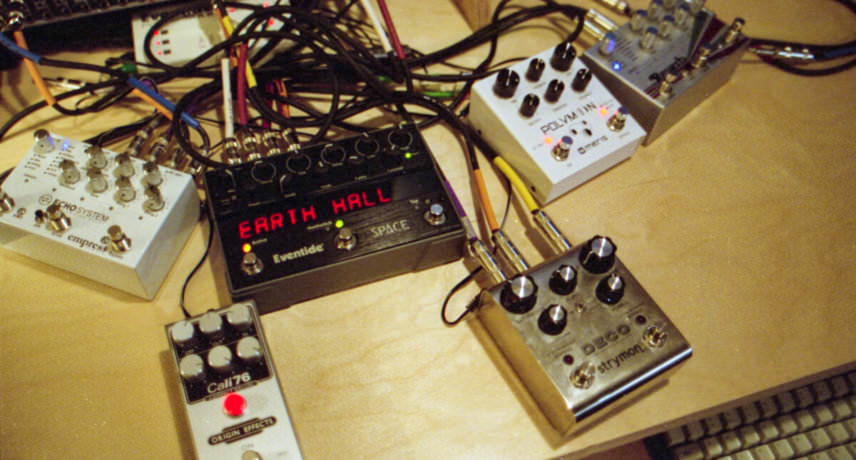


Guitar Pedals
We’ve tried a bunch of different pedals and currently have six that perform a variety of functions.
Most guitar pedals are mono so it took a bit of research to find stereo ones that we could use with our stereo synths. All the pedals are powered through an Eventide Powermax which can supply all the different voltages that are required in a single box. Beats having six different power supplies getting their cables all tangled up!
We have both the Echosystem (delay) and Reverb pedals from Empress Effects. They’re digital, but you wouldn’t know that from listening to them, as they both do an amazing job emulating the sound of many well-known analog effects. The Echosystem is probably our most-used pedal, we love being able to cycle through the Space Echo, Memory Man and Bucket Brigade modes to find the character we want as quickly as possible. It’s also fun to turn up the feedback and get crazy tails.
For the reverb, the hall and plate presets are really nice, but the winner is Empress’s proprietary Ghost reverb mode which uses modulating resonance peaks to achieve a uniquely spooky sound. The thing we love most about these pedals is the simplicity of them- there are only 8 knobs on each (no screen) and yet they both are amazingly playable and easily customizable.
We use the Eventide Space reverb unit mostly for the famous Black Hole preset. It’s not as immediate as our other pedals but it sounds amazing. We’ve contemplated getting rid of it in favor of the Black Hole VST, but somehow it manages to stick around. It also has a cool pitch-drifting effect when the size knob is turned, which none of our other pedals have.
The Strymon Deco is a tape emulator that can function as a phaser, flanger, chorus, and single-tap delay all in one! We love pairing it with our mono synths to add stereo width and movement. It works wonders on bass tones and is capable of some really vibey effects.
The Meris Polymoon is the black sheep of the bunch, there’s nothing really like it out there. It’s technically a delay pedal, but it’s really in a category of its own. We like to joke that we could make an entire album with just the Polymoon. Turning the time knob creates an insane pitch-shifting effect, and it’s capable of generating absolutely insane sounds. In Magna we ran a couple vocal phrases through it and just let it rip. It can be a bit hard to control but the results are worth it!
Finally we have the Cali 76 compressor pedal, which is a mini emulation of the 1176. we primarily use it with our TR-8S for drums, but sometimes use it on basses as well. The remarkable thing is that it’s fully analog but still fits inside a tiny pedal!
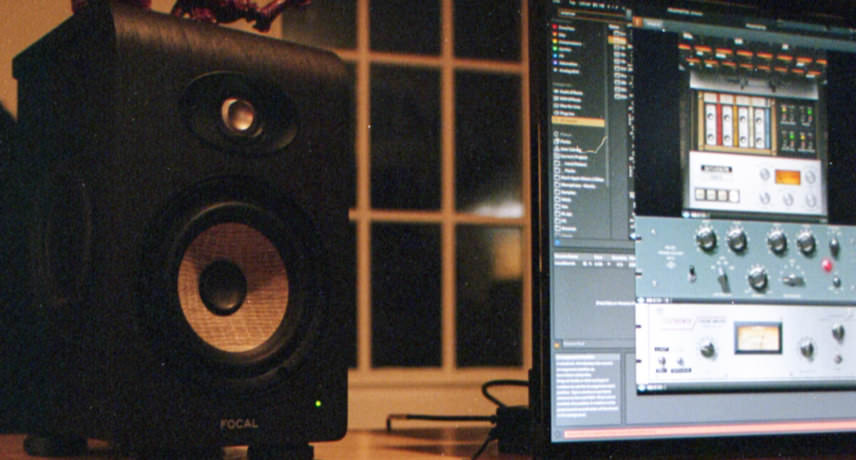


Focal Shape 50 + Sennheiser HD600
Our monitoring system consists of a pair of Focal Shape 50s and a JBL Subwoofer.
We upgraded to the Focals 2 years ago, and the sound blew us away! We had previously used larger speakers when we first moved into this room without realizing that smaller speakers are better suited to small rooms, and as a result had a ton of bass buildup that made mixing our low end really difficult. The matching Focal sub is next on our buy list!
For headphones, we use the Sennheiser HD600s. They are not as popular as the ubiquitous HD650s but we think they sound amazing, and they’ve lasted us 3+ years of almost daily use. Although we trust our speakers as the final word, it’s always important for us to reference the mix in the headphones.
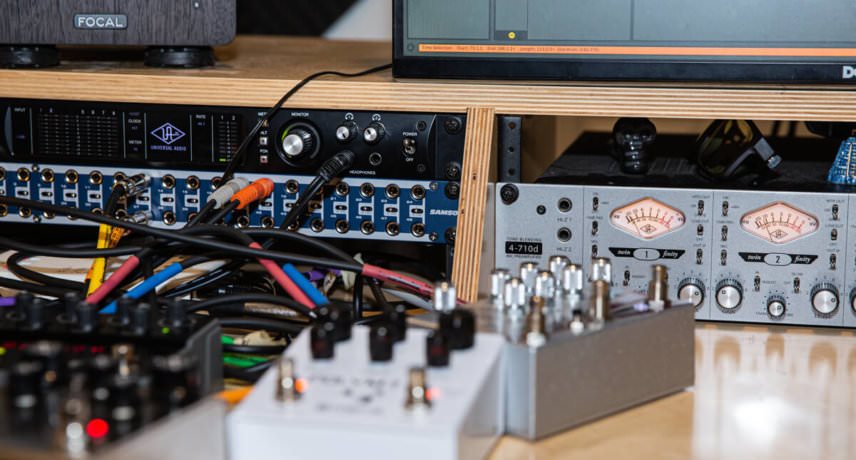


UAD Apollo 8, UAD 4-710D Mic Preamp, Samson Patchbay, Plug-ins
Over the past couple years, we’ve slowly added to and upgraded our I/O as the gear collection has grown.
Right now we are recording through all Universal Audio inputs. We have an Apollo 8 + Apollo Twin on the digital side, and a UAD 4-710D tube preamp for some analog flavour.
The Apollo pres are super clean sounding, and that allows us to use the UAD virtual console to shape the sound with saturation, compression, and EQ before it’s even entered the DAW. This speeds along our mixing workflow; if each individual track already sounds good upon recording then it needs much less work later in the box.
The 4-710D handles our mono-synths and our drum machine. It has both a solid-state and tube pre-amp on each channel, as well as blend knob so that you can mix the two together. Each channel also has a built-in 1176 compressor circuit that we absolutely love on drums.
We also have everything (including some digital outputs from the Apollo 8) running through a Samson patchbay so that we can easily chain together pedals or use them as sends. This adds some much-needed flexibility to our analog processing chains and also allows us to use our pedals and synths as effects in Ableton.
On the plug-in side, we use copious amounts of UAD during both tracking and mixing. We strive to keep an analog edge to our sound even though we mix in the box, and we think UAD does an amazing job with its emulations of so many pieces of classic gear. T
he Soundtoys bundle is also a must-have in our opinion! We use and love almost every plugin in there. We are huge believers in saturation so we have a wide variation of plugins to color our sound. Some standouts are the Black Box HG-2, UAD Studer A800, and the Klanghelm SDRR2.
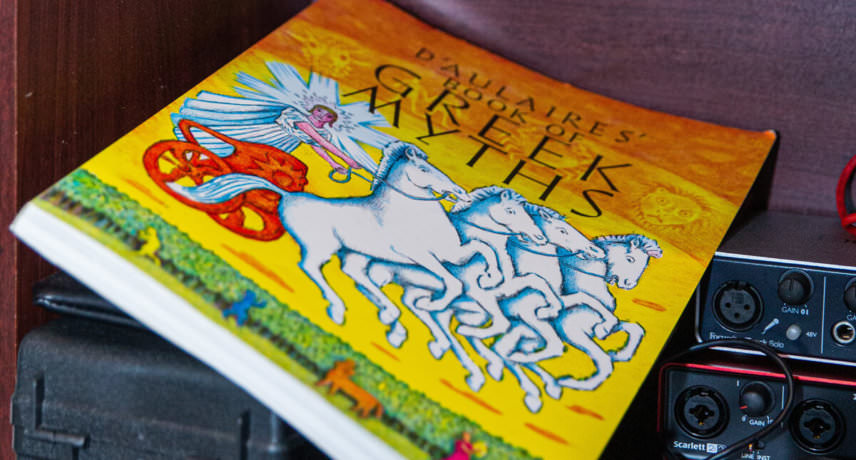


Random Trinkets
As we spend a lot of time in the studio it’s important to make it as comfortable and inviting as possible. We’ve decorated it with a lot of trinkets and decorative pieces that remind us of fond memories and people we love, and a large rug that ties it all together.
In each of the corners you can find compasses (both the direction-pointing kind as well as the circle-drawing kind), Reed’s old broken sunglasses, and a variety of small figurines. We have a Ganesha (the Hindu god of creativity and art, among other things) on one speaker and a Chinese dragon on the other.
We also have a copy of D’Aulaires’ Book of Greek Myths from which we draw a lot of our track names (Poseidon, Demeter, Cygnus, etc.). We love mythology and being inspired by its stories. We’ve gone through a lot of the Greek names now so we’re starting to incorporate some from Asian mythology like the Ramayana and Journey to the West as well.
Photo Credit: Liam Schwarz
Local Dialect’s “November EP” is out now on Purified Records. Find them on Facebook, Twitter & Soundcloud.
